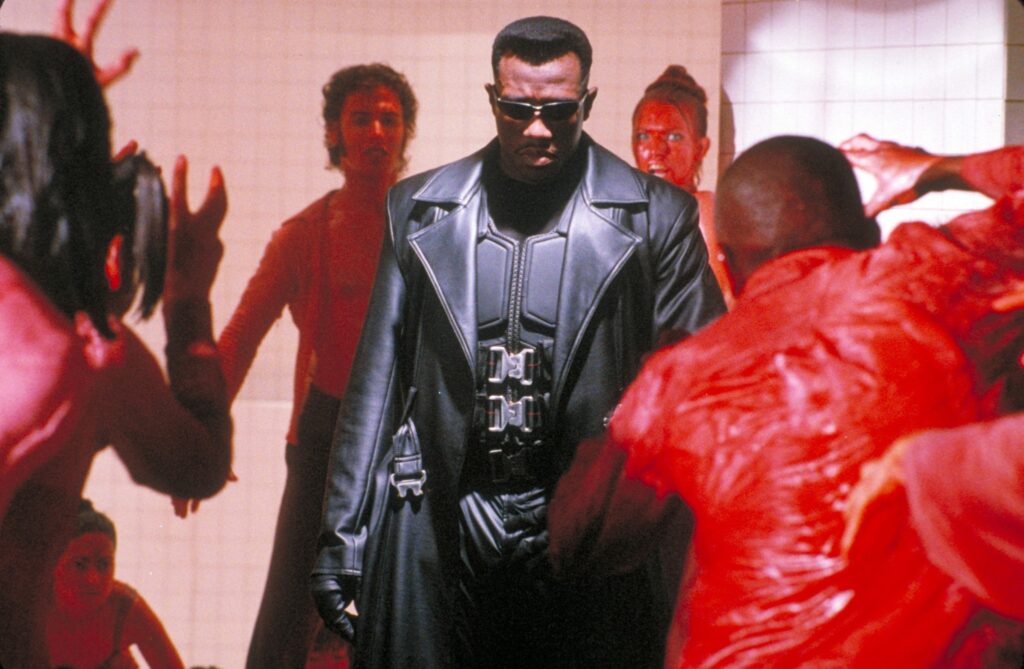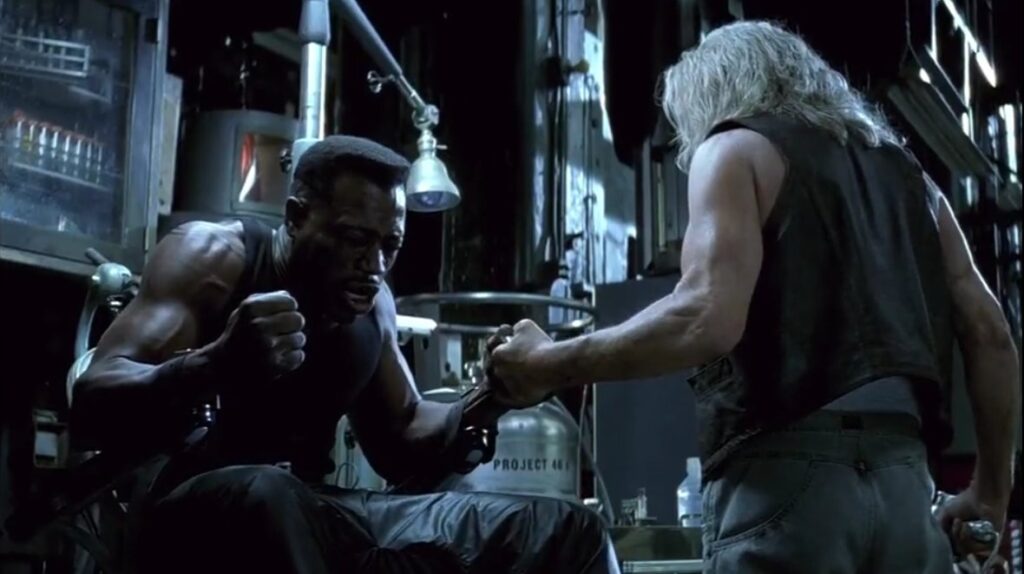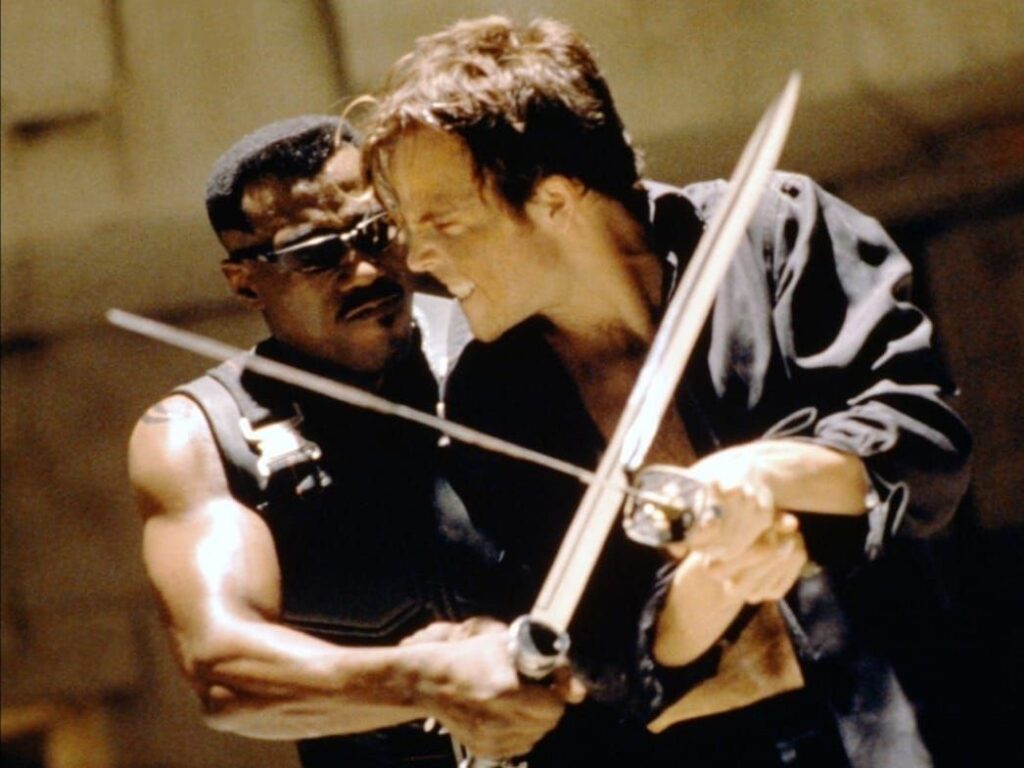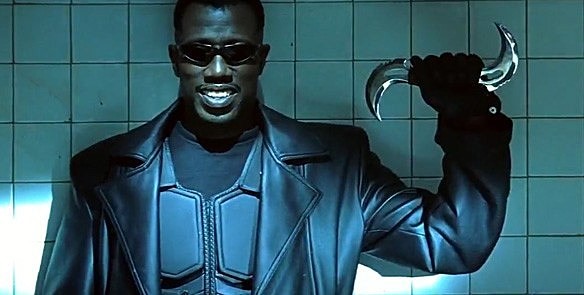| Dan Howard |

Blade plays on glorious 35mm at the Trylon Cinema from Friday, April 4th, through Sunday, April 6th. For tickets, showtimes, and other series information, visit trylon.org.
Every generation has its defining film genre. For the 40s, it was Noir. The 70s were ruled by the auteurs, the 80s were all about sci-fi and fantasy and for the 50s and 60s, we had Westerns at the Hollywood throne. However, for the last 25 years or so, Superhero film and TV has been this generation’s defining genre. Whether you’re an avid fan, keeping up with every new Marvel and DC film and TV series, or have started feeling genre fatigue, it’s hard to escape the superhero craze that has reigned over film entertainment since the early 2000s. Which films do we think of the earliest superhero movies? Richard Donner’s Superman (1978), Superman II (1980) and Tim Burton’s Batman (1989), Batman Returns (1992), or even Adam West’s zany 1966 Batman movie come to mind. As widely regarded as they are, none of them have helped usher in the renaissance of Superhero films quite like Wesley Snipes’s performance of the titular vampire killer.
After his mother was bitten by a vampire and dies after his birth, Blade (Wesley Snipes) grows up to be a day walker (a vampire who can walk in the sun). Years later, Blade has become a vampire hunter, hellbent on taking revenge for his mother’s death. When a doctor, Karen Jensen (N’Bushe Wright), is bitten by one of Blade’s injured targets, Blade takes her back to his hideout where his mentor and weaponsmith, Abraham Whistler (Kris Kristofferson), attempts to reverse her transformation process. Karen joins Blade in the hunt for a vampire syndicate and the vampire who bit his mother, Deacon Frost, to thwart their plans of conjuring up a vampire God using the blood of a day walker—the blood of Blade.
While Westerns and Superhero films are not entirely alike, it’s difficult to ignore the similarities that they do share. Blade’s opening scene alone shows reminiscence of Sergio Leone’s work. Blade’s entrance in the vampires’ night club bares similarities with how Clint Eastwood’s Man With No Name first appears on screen in For a Few Dollars More. Blade, in a sense, is that badass cowboy himself, his leather trench coat serving as its own version of Eastwood’s Dollars poncho. He carries a gun and even wields a katana, reflecting on the influences Westerns and samurai films consistently shared with each other. Not to mention that the great Kris Kristofferson, an actor who acted in a few Westerns himself, plays a prominent role in the film and is just as downright badass as Whistler.

The themes of heroism, struggling against adversity, and justice are a given in the age-old fight of “Good vs. Evil.” But beyond these surface level parallels lies themes of morality, revenge, and retribution. While certain Westerns such as Unforgiven (1992), The Searchers (1956), Tombstone (1995) and Once Upon a Time in the West (1968) embody these themes, Blade possess all of these and more. His morality complex emerges with the desire for avenging his mother, saving Karen, and finding his personal retribution amongst all living vampires. His lifelong quest for justice and revenge mirrors so much of what we’ve seen in Westerns. Ultimately, the biggest connection of Westerns and Superhero films (and truthfully so many others) is the incorporation of the tried-and-true Hero’s Journey formula. Blade has his “call to adventure” in hunting the vampires and undergoes every bit of what makes a Hero’s Journey life altering for any main character. Blade may very well have been the first major steppingstone for Superhero movies, inaugurating the natural progression of a film genre the people can’t get enough of. Given all the subtle Western aspects within Blade, it’s the one film that builds the perfect bridge between Westerns and Superheroes.
Blade had gone places where no superhero film had gone before. It’s a smaller, more personal story, yet the stakes feel so high. It’s an emotional character study lined with action, suspense, and blood. Blade went to depths that weren’t quite reached in many of its predecessors. Of course there were some emotional aspects to earlier superhero films, but there wasn’t much exploration of themes of chosen family in the genre until Blade came about. With Abraham Whistler acting as the main parental figure in Blade’s life and Karen finding herself in the middle of their war against the vampires, it’s hard to imagine that Blade meeting either of them is anything other than fate. Blade had no choice in being born the way he is. I believe Whistler could see the goodness in Blade’s heart when they first met and Whistler wanting to help him. He creates the serum that helps combat Blade’s bloodthirst, allowing him to push down and reject that monstrous part of his being after seeing the toll it takes on Blade’s mental health. And Karen acts as the perfect person to balance everything out. Amidst his chaotic life, Karen is an anchor for Blade, keeping him more in check with the world outside of the vampire underground and reminding him of his humanity. Those kinds of emotional deep dives we don’t see much of in the average superhero blockbuster.
You’d think more filmmakers would take notice, right? Even if they’re not the ones making the films. I can’t even begin to tell you how many big-name directors like Martin Scorsese, Quentin Tarantino (although he’s more indifferent towards them), and Alejandro Inarritu openly criticize superhero movies. Yet, while they give their two cents on the latest Marvel blockbuster, they won’t hesitate to tell you their favorite Western or even make one of their own. Scorsese praises The Searchers, for instance. What kind of film is Inarritu’s The Revenant? A Western. Tarantino not only has he made a Western himself—The Hateful Eight (2015)—he also wrote a portion of Once Upon a Time… In Hollywood (2019) to take place on a ranch that formerly hosted Western productions and has written full episodes of the TV show that Rick Dalton (Leonardo DiCaprio) starred in, Bounty Law. Tarantino’s main gripe with Marvel movies is that there’s no singular vision and that every director is creating at the will of one producer whose vision changes quite often. Alejandro Inarritu’s criticisms lie more in that he “sees heroes every day” and that you don’t need powers to be considered a hero and even goes as far as to refer to Superheroes as “sad figures.”

Like the directors that speak out against superhero movies today, there were filmmakers like Ingmar Bergman who laughed at the idea of making a Western when asked about it in an interview. ( Ingmar Bergman and a Western… | Immagini, Film, Ritratti ) It seems that whatever the biggest genre of the time may be, there will always be those who push back against potential conformity to make what’s true to their own artistic principles. While I understand this sentiment, I’m less inclined to agree that any one type of film should be devalued. I do agree with Paul Thomas Anderson when he advised John Krasinski against calling any film bad: “In our business, we’ve all got to support each other. You’ve got to support the big swing. If you put it out there the that the movie’s not good, they won’t let us make more movies like that.”
Even with all the ways Blade helped the genre reach new heights, the film also set a rather disappointing trend for superhero movies, where the antagonist has the same powers as the hero—something that studios like Marvel still incorporate. But in the case of Blade, his powers are both similar and different from the vampires he hunts. As a Dhampir (human-vampire hybrid), he possess the same abilities as vampires and none of their weakness aside from consuming human blood. His super speed, strength, stamina, and accelerated healing make him more powerful than his vampire counterparts. Deacon Frost is really the main curveball in the story. One feature of modern superhero films is having their villains be sympathetic, but Blade is not amongst the guilty parties of this plot trope. Deacon Frost is a straightforward villain. Evil, pure and simple. While Blade is technically categorized as an anti-hero, he’s still fighting the monsters that threaten innocent lives and push his limits in multiple ways. Therefore, Blade is a hero in the most classic sense.

How many kids do you see walking around do you see dressed up as Spider-Man or Batman? How many kids in the 50s and 60s were walking around dressed as cowboys and carrying plastic toy guns and walking around wanting to be John Wayne or Clint Eastwood? In the same way that today’s iconic directors make their own Westerns many decades after the genre’s heyday, we’ll see more filmmakers make their own superhero epics in the future, because they grew up with the genre’s golden age. They can and will continue to push the boundaries of these films. Steven Spielberg once claimed that superhero movies “will go the way of the Western,” meaning that the genre will fade away in the same way Westerns have, with only occasional new films or TV series emerging here and there. However, I picture the anticipation when Clint Eastwood made another Western (Unforgiven) and that it was a similar euphoric and nostalgic feeling as when Wesley Snipes (spoiler alert) finally reprised his role as Blade in Deadpool & Wolverine (2024) Through all of the ups and downs, we see how filmmakers put in the effort to keep reinventing the superhero genre wheel. They keep it thriving, leaving the future of the genre open to any new possibilities. And we have Blade to thank for those first steps.
Edited by Olga Tchepikova-Treon
